The Spatial Distribution and Influencing Factors of Heavy Metals in Soil in Xinjiang, China
Abstract
:1. Introduction
2. Materials and Methods
2.1. Study Area
2.2. Data Source and Preprocessing
2.3. Research Methods
2.3.1. Variance Function
2.3.2. Ordinary Kriging Method
2.3.3. Nemero Integrated Pollution Index
2.4. Statistical Analysis and Graphing
3. Results and Discussion
3.1. Descriptive Statistics of Heavy Metal Content in the Soil
3.2. Spatial Variability Characteristics of Heavy Metal Content in the Soil
3.3. Spatial Distribution of Heavy Metals
3.4. Characteristics of Heavy Metal Accumulation in Soil in Xinjiang
3.5. Impact of Socio-Economic Development on Soil Pollution Due to Heavy Metals in Xinjiang
4. Conclusions
- (1)
- The average values of Cd, Cr, Cu, Ni, Pb, and Zn in the soils were 2.858, 1.062, 1.194, 1.159, 1.192, and 1.086 times the background values in Xinjiang, respectively. The Cd and Pb block gold coefficients were greater than 25% and less than 50%, indicating an obvious spatial correlation between Cd and Pb in soil due to the joint action of anthropogenic and natural factors.
- (2)
- The proportion of soil pollution due to heavy metals in Xinjiang was 89.13%, with an overall trend of decrease from north to south. Karamay, Changji, and Kashi were at heavy pollution levels, and the pollution degree of each heavy metal followed the order of Cd > Cu > Pb > Ni > Zn > Cr.
- (3)
- The heavy metal Pb in soil was significantly and positively correlated with the agricultural GDP with a 0.605 correlation coefficient. Cd was significantly and positively correlated with comprehensive energy consumption with a 0.518 correlation coefficient. Additionally, Cd was more significantly correlated with the industrial GDP. Therefore, agricultural activities, comprehensive energy consumption, and industrial production were the main socio-economic factors affecting the heavy metal content in the soil in Xinjiang.
Author Contributions
Funding
Institutional Review Board Statement
Informed Consent Statement
Data Availability Statement
Conflicts of Interest
References
- Chen, W.X.; Li, Q.; Wang, Z.; Sun, Z.J. Spatial distribution characteristics and pollution evaluation of heavy metals in farmland soil in China. Environ. Sci. 2020, 41, 2822–2833. [Google Scholar]
- Wang, Y.Z.; Duan, X.J.; Wang, L. Spatial distribution and source analysis of heavy metals in soils influenced by industrial enterprise distribution: Case study in Jiangsu Province. Sci. Total Environ. 2020, 710, 134593. [Google Scholar] [CrossRef] [PubMed]
- Guagliardi, I.; Cicchella, D.; De Rosa, R. A geostatistical approach to assess concentration and spatial distribution of heavy metals in urban soils. Water Air Soil Pollut. 2012, 223, 5983–5998. [Google Scholar] [CrossRef]
- Duffus, J.H. “Heavy metals”—A meaningless term? Pure Appl. Chem. 2002, 74, 793–807. [Google Scholar] [CrossRef]
- Bi, X.Y.; Liang, S.Y.; Li, X.D. A novel in situ method for sampling urban soil dust: Particle size distribution, trace metal concentrations, and stable lead isotopes. Environ. Pollut. 2013, 177, 48–57. [Google Scholar] [CrossRef]
- Niu, L.L.; Yang, F.X.; Xu, C.; Yang, H.Y.; Liu, W.P. Status of metal accumulation in farmland soils across China: From distribution to risk assessment. Environ. Pollut. 2013, 176, 55–62. [Google Scholar] [CrossRef]
- Hu, S.M.; Chen, X.M.; Jing, F.; Liu, W.; Wen, X. An assessment of spatial distribution and source identification of five toxic heavy metals in Nanjing, China. Environ. Eng. Res. 2021, 26, 200135. [Google Scholar] [CrossRef]
- Peng, C.; He, Y.L.; Guo, Z.H.; Xiao, X.Y.; Zhang, Y. Characteristics and risk assessment of heavy metals in urban soils of major cities in China. Environ. Sci. 2022, 43, 1–10. [Google Scholar]
- Su, R.K.; Ou, Q.Q.; Wang, H.Q.; Dai, X.R.; Chen, Y.H.; Luo, Y.T.; Yao, H.S.; Ouyang, D.X.; Li, Z.S.; Wang, Z.X. Organic-inorganic composite modifiers enhance restoration potential of Nerium oleander L. to lead-zinc tailing: Application of phytoremediation. Environ. Sci. Pollut. Res. 2023, 30, 56569–56579. [Google Scholar] [CrossRef]
- He, L.J.; Su, R.K.; Chen, Y.H.; Zeng, P.; Du, L.; Cai, B.; Zhang, A.S.; Zhu, H.H. Integration of manganese accumulation, subcellular distribution, chemical forms, and physiological responses to understand manganese tolerance in Macleaya cordata. Environ. Sci. Pollut. Res. 2022, 29, 39017–39026. [Google Scholar] [CrossRef]
- Dai, L.J.; Wang, L.Q.; Li, L.F.; Liang, T.; Zhang, Y.Y.; Ma, C.X.; Xing, B.S. Multivariate geostatistical analysis and source identification of heavy metals in the sediment of Poyang Lake in China. Sci. Total Environ. 2018, 621, 1433–1444. [Google Scholar] [CrossRef] [PubMed]
- Huang, T.; Deng, Y.H.; Zhang, X.L.; Wu, D.S.; Wang, X.L.; Huang, S. Distribution, source identification, and health risk assessment of heavy metals in the soil-rice system of a farmland protection area in Hubei Province, Central China. Environ. Sci. Pollut. Res. 2021, 28, 68897–68908. [Google Scholar] [CrossRef] [PubMed]
- Wu, W.; Xie, D.Y.; Liu, H.B. Spatial variability of soil heavy metals in the three gorges area: Multivariate and geostatistical analyses. Environ. Monit. Assess. 2009, 157, 63–71. [Google Scholar] [CrossRef] [PubMed]
- Borkowski, A.S.; Kwiatkowska-Malina, J. Geostatistical modelling as an assessment tool of soil pollution based on deposition from atmospheric air. Geosci. J. 2017, 21, 645–653. [Google Scholar] [CrossRef]
- Reza, S.K.; Baruah, U.; Singh, S.K.; Das, T.H. Geostatistical and multivariate analysis of soil heavy metal contamination near coal mining area, Northeastern India. Environ. Earth Sci. 2015, 73, 5425–5433. [Google Scholar] [CrossRef]
- Thomas, I.H.L.; Bautista, F.; Ruíz, F.R.C.; Delgado, M.D.; Owen, P.Q.; Aguilar, D.; Goguitchaichvili, A. Concentration of toxic elements in topsoils of the metropolitan area of Mexico City: A spatial analysis using ordinary kriging and indicator kriging. Rev. Int. Contam. Ambient. 2015, 31, 47–62. [Google Scholar]
- Mahmoudabadi, E.; Sarmadian, F.; Moghaddam, R.N. Spatial distribution of soil heavy metals in different land uses of an industrial area of Tehran (Iran). Int. J. Environ. Sci. Technol. 2015, 12, 3283–3298. [Google Scholar] [CrossRef]
- Du, H.L.; Wang, J.S.; Wang, Y.; Yao, Y.B.; Liu, X.Y.; Zhou, Y. Contamination characteristics, source analysis, and spatial prediction of soil heavy metal concentrations on the Qinghai-Tibet Plateau. J. Soil. Sediment. 2023, 23, 2202–2215. [Google Scholar] [CrossRef]
- Castañeda-Espinoza, J.; Salinas-Sánchez, D.O.; Mussali-Galante, P.; Castrejón-Godínez, M.L.; Rodríguez, A.; González-Cortazar, M.; Zamilpa-Alvarez, A.; Tovar-Sánchez, E. Dodonaea viscosa (Sapindaceae) as a phytoremediator for soils contaminated by heavy metals in abandoned mines. Environ. Sci. Pollut. Res. 2023, 30, 2509–2529. [Google Scholar] [CrossRef]
- Tong, Y.L.; Yue, T.; Gao, J.J.; Wang, K.; Wang, C.L.; Zuo, P.L.; Zhang, X.X.; Tong, L.; Liang, Q.M. Partitioning and emission characteristics of Hg, Cr, Pb, and as among air pollution control devices in Chinese coal-fired industrial boilers. Energy Fuels 2020, 34, 7067–7075. [Google Scholar] [CrossRef]
- Eziz, M.; Mohammad, A.; Mamut, A.; Hini, G. A human health risk assessment of heavy metals in agricultural soils of Yanqi Basin, Silk Road Economic Belt, China. Hum. Ecol. Risk Assess. 2018, 24, 1352–1366. [Google Scholar] [CrossRef]
- Mamut, A.; Eziz, M.; Mohammad, A.; Anayit, M.; Rixit, A. Contamination and risk assessment of heavy metals in farmland soils of Baghrash County, Xinjiang, Northwest China. Sci. Cold Arid. Reg. 2017, 9, 467–475. [Google Scholar]
- Mamut, A.; Eziz, M.; Mohammad, A. Pollution and ecological risk assessment of heavy metals in farmland soils in Yanqi County, Xinjiang. Eurasian Soil Sci. 2018, 51, 985–993. [Google Scholar] [CrossRef]
- Li, Y.F.; Zhou, P.; Shen, X.Y.; Zhao, K. Molybdenum fertilizer improved antioxidant capacity of Chinese merino sheep under compound contamination. Biol. Trace Elem. Res. 2023, 201, 1717–1725. [Google Scholar] [CrossRef] [PubMed]
- Turhun, M.; Eziz, M. Identification of the distribution, contamination levels, sources, and ecological risks of heavy metals in vineyard soils in the main grape production area of China. Environ. Earth Sci. 2022, 81, 40. [Google Scholar] [CrossRef]
- Sawut, R.; Kasim, N.; Maihemuti, B.; Hu, L.; Abliz, A.; Abdujappar, A.; Kurban, M. Pollution characteristics and health risk assessment of heavy metals in the vegetable bases of northwest China. Sci. Total Environ. 2018, 642, 864–878. [Google Scholar] [CrossRef]
- Li, Y.W.; Mo, Z.X.; Xue, J.P.; Zhang, L.; Zha, X.H. Pollution evaluation and source apportionment of heavy metals in soils from Kashi region, Xinjiang, China. J. Arid Land Resour. Environ. 2020, 34, 147–153. [Google Scholar]
- Zhang, H.W.; Zhang, F.; Song, J.; Tan, M.L.; Kung, H.T.; Johnson, V.C. Pollutant source, ecological and human health risks assessment of heavy metals in soils from coal mining areas in Xinjiang, China. Environ. Res. 2021, 202, 111702. [Google Scholar] [CrossRef]
- Wang, W.; Lai, Y.S.; Ma, Y.Y.; Liu, Z.L.; Wang, S.F.; Hong, C.L. Heavy metal contamination of urban topsoil in a petrochemical industrial city in Xinjiang, China. J. Arid Land 2016, 8, 871–880. [Google Scholar] [CrossRef]
- Rong, B.; Chu, C.J.; Zhang, Z.; Li, Y.T.; Yang, S.H.; Wang, Q. Assessing the coordinate development between economy and ecological environment in China’s 30 Provinces from 2013 to 2019. Environ. Model. Assess. 2023, 28, 303–316. [Google Scholar] [CrossRef]
- Wang, X.L.; Sun, Y.J.; Zhang, L.P.; Mei, Y.A. Spatial variation and influence factor analysis of soil heavy metal As based on geoDetector. Stoch. Environ. Res. Risk Assess. 2021, 35, 2021–2030. [Google Scholar] [CrossRef]
- Chen, Q.Q.; Taylor, D. Economic development and pollution emissions in Singapore: Evidence in support of the Environmental Kuznets Curve hypothesis and its implications for regional sustainability. J. Clean. Prod. 2020, 243, 118637. [Google Scholar] [CrossRef]
- Website of the People’s Government of Xinjiang Uygur Autonomous Region. Statistical Bulletin on National Economic and Social Development of Xinjiang Uygur Autonomous Region in 2022 (28 March 2023). 2023. Available online: http://www.xinjiang.gov.cn/xinjiang/tjgb/202303/a527e6eb22524c40bc7fca952a05710e.shtml (accessed on 20 July 2023).
- Wang, S.; Cai, L.M.; Wang, Q.S.; Luo, J.; Tang, C.H.; Mu, G.Z.; Jiang, H.H.; Liu, T.Y. Spatial distribution and accumulation of heavy metals in urban surface dust of China. Geogr. Res. 2018, 37, 1624–1640. [Google Scholar]
- Ju, Q.D.; Hu, Y.B.; Xie, Z.G.; Liu, Q.M.; Zhang, Z.G.; Liu, Y.; Peng, T.S.; Hu, T.F. Characterizing spatial dependence of boron, arsenic, and other trace elements for Permian groundwater in Northern Anhui plain coal mining area, China, using spatial autocorrelation index and geostatistics. Environ. Sci. Pollut. Res. 2023, 30, 39184–39198. [Google Scholar] [CrossRef]
- China National Environmental Monitoring Centre. Background Values of Soil Elements in China; China Environmental Science Press: Beijing, China, 1990. [Google Scholar]
- Guo, H.; Sun, Y.J.; Wang, X.L.; Zhang, L.P.; Mei, Y.A.; Liu, Q.H.; Wang, Q. Spatial distribution characteristics and source analysis of soil heavy metals in county-level city. Acta Sci. Circumstantiae 2022, 42, 287–297. [Google Scholar]
- Zhang, X.M.; Zhang, X.Y.; Zhong, T.Y.; Jiang, H. Spatial distribution and accumulation of heavy metal in arable land soil of China. Environ. Sci. 2014, 35, 692–703. [Google Scholar]
- Chen, Y.F.; Zeng, Y.Y.; Zhou, J.L.; Wang, S.T.; Du, J.Y.; Liu, Y.F. Spatial distribution characteristics and influence factors of soil heavy metal contents in oasis area of Yutian County, Xinjiang. Trans. Chin. Soc. Agric. Mach. 2019, 50, 263–273. [Google Scholar]
- Lai, Y.S.; Ma, Y.Y.; Wang, W.; Wang, S.F.; Hong, C.L.; Shi, L. Assessment of heavy metal pollution and potential ecological risks of soils in Shawan of Xinjiang. J. Shihezi Univ. 2016, 34, 518–523. [Google Scholar]
- Biral, I.; Abdu, A.A.; Shi, Q.D.; Liu, S.H.; Nigati, K.; Li, H. Pollution and source identification of heavy metals in surrounding soils of Eastern Junggar Coalfield based on PMF model. Trans. Chin. Soc. Agric. Eng. 2019, 35, 185–192. [Google Scholar]
- Jiang, Y.T.; Sun, Y.J.; Zhang, L.P.; Wang, X.L. Influence factor analysis of soil heavy metal Cd based on the GeoDetector. Stoch. Environ. Res. Risk Assess. 2020, 34, 921–930. [Google Scholar] [CrossRef]
- Liu, J.; Chen, X.L.; Fan, Y.F.; Chen, X.W. Spatial distribution characteristics and influencing factors of heavy metals in urban park dust in China. Environ. Chem. 2022, 41, 450–459. [Google Scholar]
- Zhang, X.X.; Zha, T.G.; Guo, X.P.; Meng, G.X.; Zhou, J.X. Spatial distribution of metal pollution of soils of Chinese provincial capital cities. Sci. Total Environ. 2018, 643, 1502–1513. [Google Scholar] [CrossRef]
- Qishlaqi, A.; Moore, F.; Forghani, G. Characterization of metal pollution in soils under two landuse patterns in the Angouran region, NW Iran; a study based on multivariate data analysis. J. Hazard. Mater. 2009, 172, 374–384. [Google Scholar] [CrossRef]
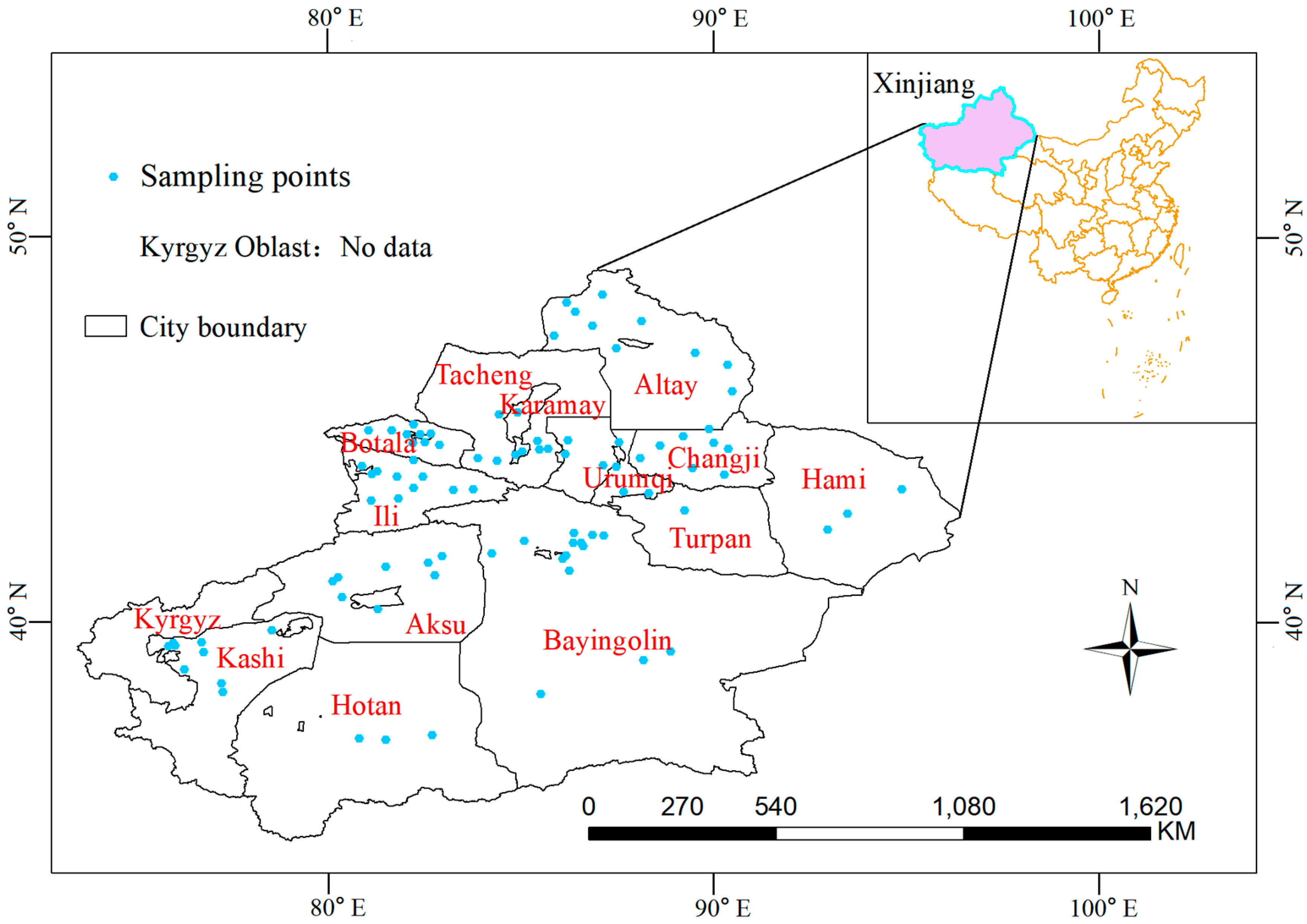
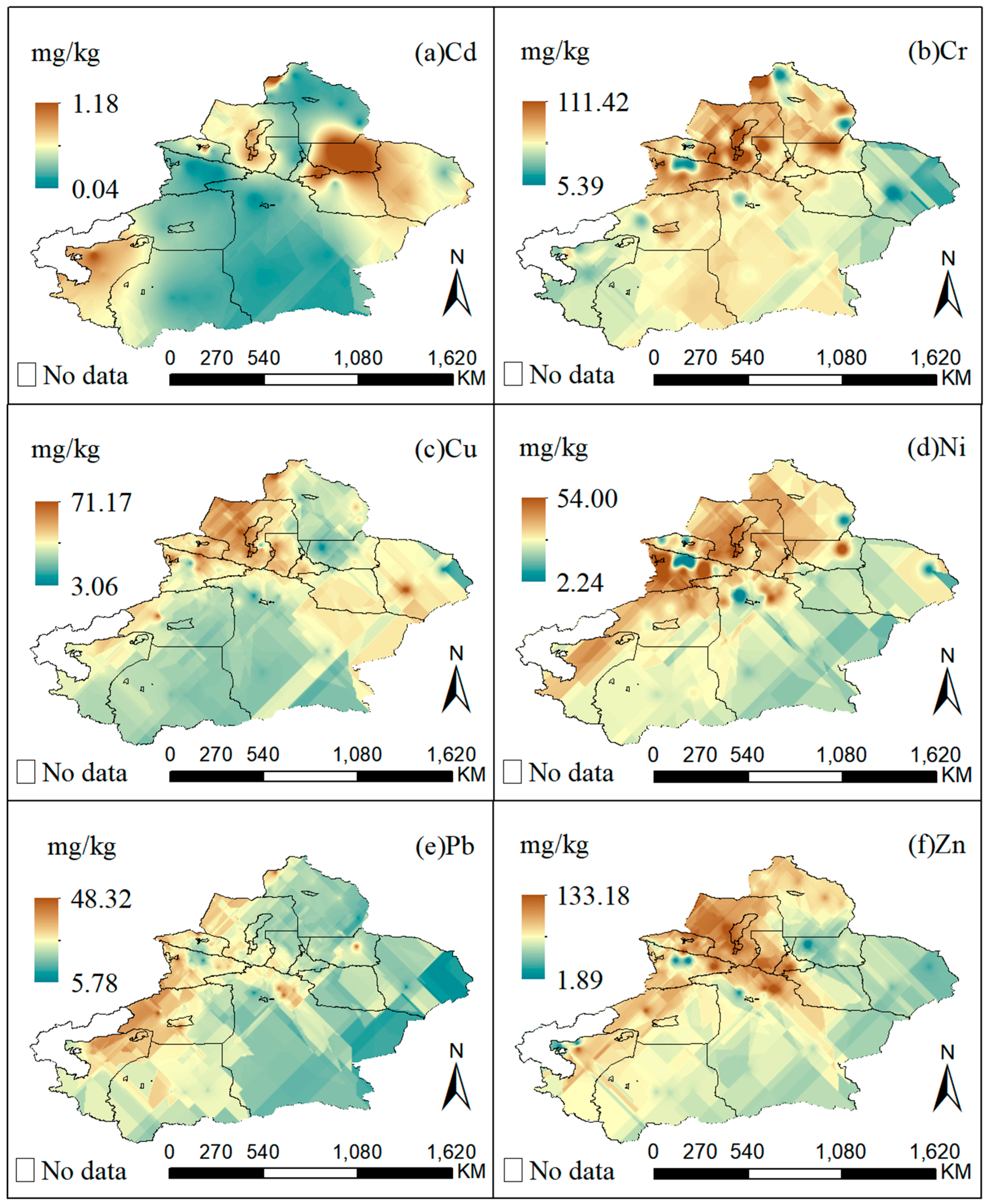
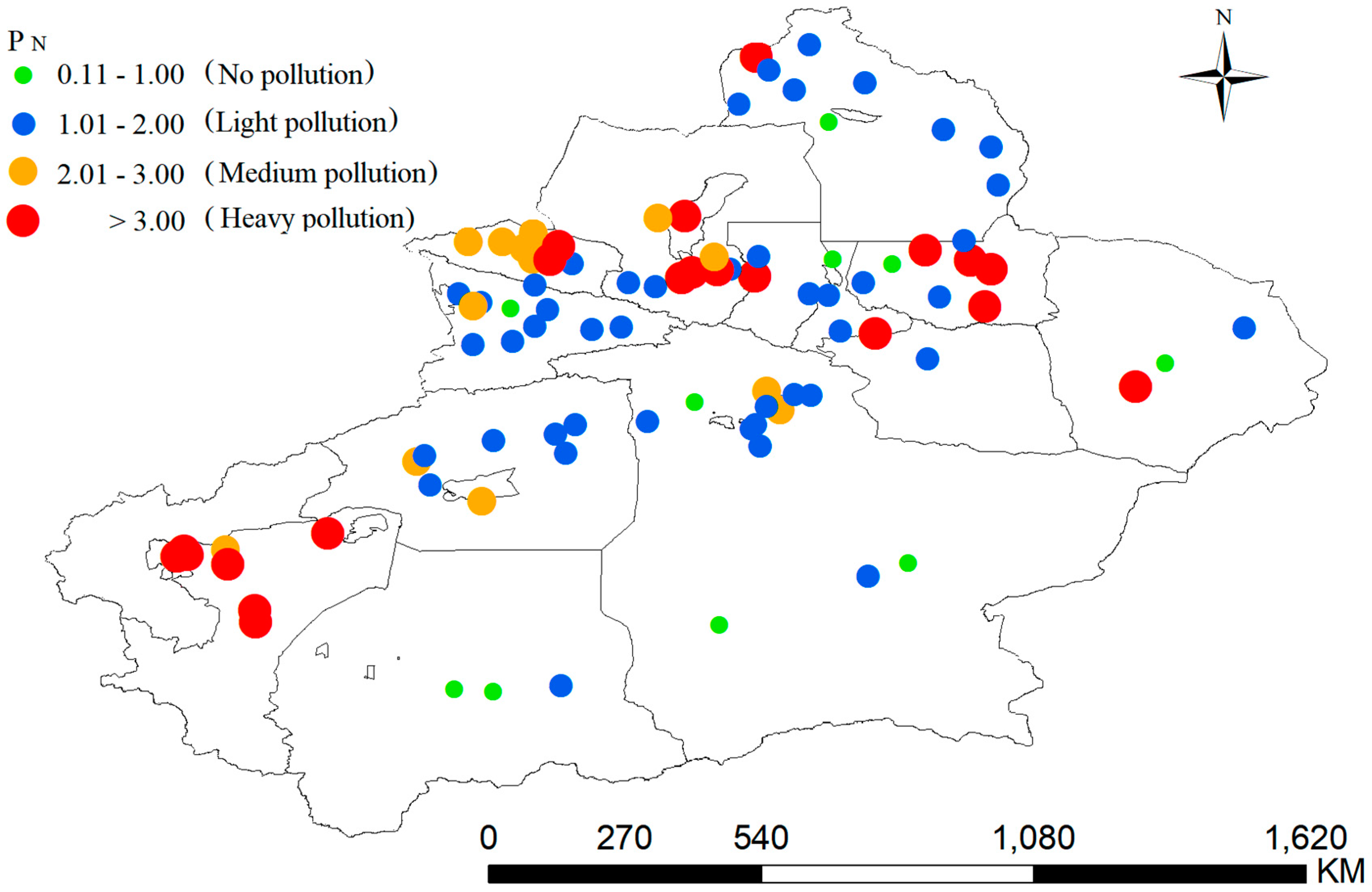
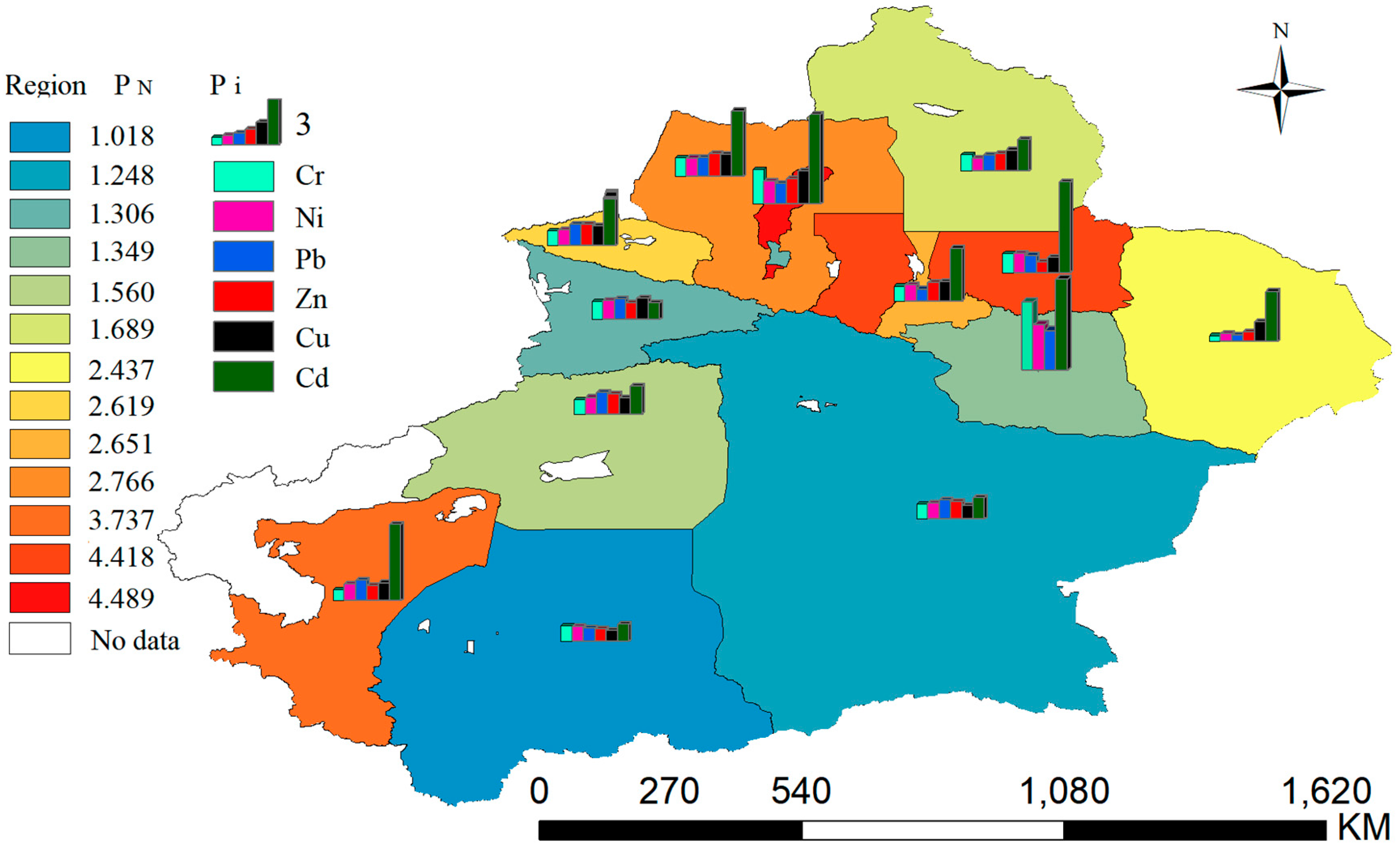
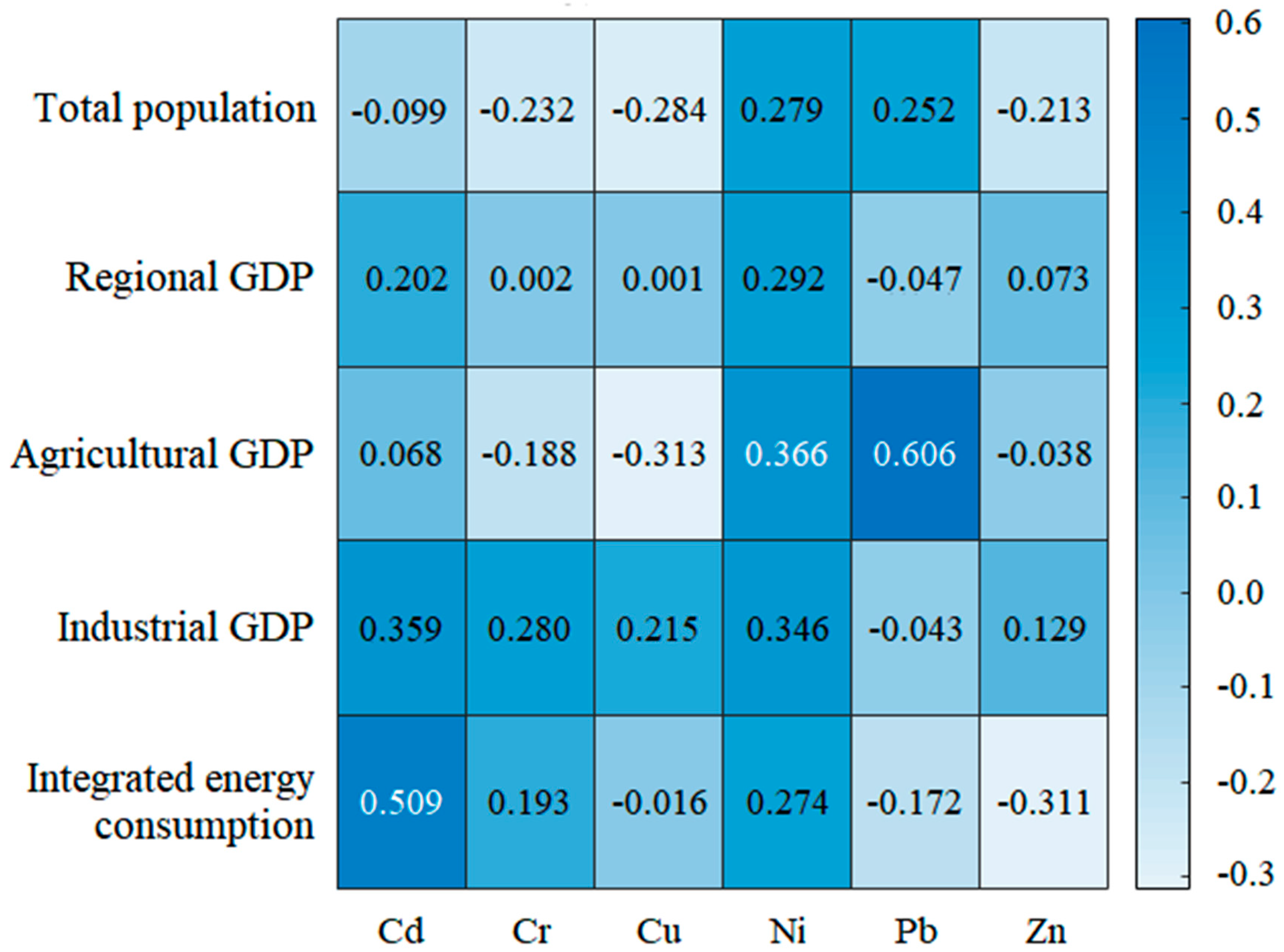
| Region | Total Population | Regional GDP/ Million | Agricultural GDP/Million | Industrial GDP/Million | Integrated Energy Consumption/Million Tons of Standard Coal |
|---|---|---|---|---|---|
| Aksu | 2,561,674 | 122,242.57 | 27,573.28 | 38,418.30 | 4.50 |
| Altay | 657,265 | 33,916.12 | 5650.14 | 12,256.83 | 0.68 |
| Bayingolin | 1,285,700 | 114,934.19 | 17,431.14 | 61,407.44 | 7.78 |
| Botala | 475,483 | 35,429.18 | 6830.79 | 8960.54 | 0.77 |
| Changji | 1,603,900 | 132,474.00 | 21,507.20 | 55,408.34 | 35.02 |
| Hami | 557,600 | 60,481.53 | 4126.90 | 34,114.84 | 9.68 |
| Hotan | 2,522,800 | 37,764.78 | 6871.77 | 5721.78 | 0.52 |
| Kashi | 4,624,000 | 104,832.20 | 29,592.81 | 19,987.31 | 1.13 |
| Karamay | 462,347 | 97,292.52 | 1604.48 | 66,966.29 | 11.23 |
| Tacheng | 910,800 | 69,658.18 | 24,788.14 | 15,504.91 | 1.72 |
| Turpan | 633,400 | 38,448.09 | 5397.06 | 16,963.61 | 7.00 |
| Urumqi | 3,552,000 | 341,325.87 | 2769.98 | 90,613.82 | 19.83 |
| Ili | 4,556,800 | 119,070.54 | 20,533.88 | 29,386.57 | 7.49 |
| Heavy Metal | Sample Points | Minimum Value | Maximum Value | Mean Value/ mg/kg | Standard Deviation | Variation Coefficient | Skewness | Kurtosis | The Background Values in Xinjiang/ mg/kg | Average Value of Our Agricultural Soil mg/kg [1] | China Urban Soil Mean mg/kg [8] |
|---|---|---|---|---|---|---|---|---|---|---|---|
| Cd | 79 | 0.030 | 1.270 | 0.343 | 0.287 | 0.837 | 1.406 | 1.333 | 0.12 | 0.24 | 0.49 |
| Cr | 91 | 1.410 | 117.860 | 52.373 | 23.907 | 0.456 | 0.459 | 0.688 | 49.3 | 59.97 | - |
| Cu | 85 | 0.925 | 74.609 | 31.878 | 15.121 | 0.474 | 0.810 | 0.599 | 26.7 | 28.91 | 42.1 |
| Ni | 60 | 0.877 | 55.400 | 29.204 | 10.282 | 0.352 | −0.107 | 0.572 | 25.2 | - | - |
| Pb | 91 | 1.513 | 58.970 | 23.127 | 12.805 | 0.554 | 1.053 | 0.793 | 19.4 | 32.73 | 58.5 |
| Zn | 74 | 0.593 | 136.000 | 74.732 | 30.831 | 0.413 | −0.123 | −0.115 | 68.8 | 86.52 | 156.3 |
| Element | P(k-S) | Distribution Type | Theory Models | Nugget Value | Abutment Value | Nuggets of Gold Coefficient/ | Variable Range/ | Decisions Coefficient | Residuals Square | RMSSE |
|---|---|---|---|---|---|---|---|---|---|---|
| C0 | C0 + C | % | km | R2 | RSS | |||||
| Cd | 0.000 | Logarithmic Normal | Spherical | 0.070 | 0.140 | 49.64% | 150.6 | 0.735 | 9.01 × 10−4 | 1.129 |
| Cr | 0.112 | Normal | Exponential | 0.008 | 0.125 | 6.47% | 43.9 | 0.841 | 8.76 × 10−4 | 1.024 |
| Cu | 0.079 | Normal | Gaussian | 0.072 | 0.131 | 55.02% | 347.1 | 0.762 | 6.16× 10−4 | 1.027 |
| Ni | 0.809 | Normal | Exponential | 0.016 | 0.119 | 13.26% | 24.2 | 0.713 | 1.43 × 10−2 | 0.965 |
| Pb | 0.029 | Logarithmic Normal | Spherical | 0.046 | 0.097 | 47.93% | 146.8 | 0.895 | 1.92 × 10−4 | 0.939 |
| Zn | 0.964 | Normal | Spherical | 0.130 | 0.244 | 53.41% | 611.5 | 0.732 | 2.72 × 10−4 | 0.894 |
| Regions | Cd | Cr | Cu | Ni | Pb | Zn |
|---|---|---|---|---|---|---|
| Aksu | 0.22 | 46.39 | 28.46 | 28.55 | 27.43 | 89.17 |
| Altay | 0.24 | 53.28 | 36.27 | 22.11 | 19.96 | 77.48 |
| Bayingolin | 0.17 | 48.40 | 23.71 | 26.91 | 24.05 | 76.85 |
| Botala | 0.40 | 47.04 | 34.22 | 26.83 | 26.43 | 93.48 |
| Changji | 0.71 | 62.46 | 26.87 | 33.80 | 22.14 | 48.77 |
| Hami | 0.39 | 19.16 | 34.31 | 13.57 | 8.12 | 43.06 |
| Hotan | 0.13 | 50.55 | 19.20 | 25.25 | 17.10 | 55.82 |
| Kashi | 0.60 | 35.85 | 31.04 | 29.89 | 26.12 | 66.56 |
| Karamay | 0.70 | 109.95 | 56.83 | 39.04 | 25.53 | 111.55 |
| Tacheng | 0.42 | 61.40 | 38.52 | 32.30 | 23.77 | 101.94 |
| Turpan | 0.19 | 59.00 | - | 21.00 | 13.41 | - |
| Urumqi | 0.41 | 48.19 | 33.51 | 28.32 | 14.93 | 82.89 |
| Ili | 0.13 | 59.22 | 36.93 | 32.96 | 26.04 | 73.90 |
| Average value | 0.36 | 53.91 | 33.32 | 27.73 | 21.16 | 76.79 |
| Maximum value | 0.71 | 109.95 | 56.83 | 39.04 | 27.43 | 111.55 |
| Minimum value | 0.13 | 19.16 | 19.20 | 13.57 | 8.12 | 43.06 |
| The background values in Xinjiang | 0.12 | 49.3 | 26.7 | 25.2 | 19.4 | 68.8 |
Disclaimer/Publisher’s Note: The statements, opinions and data contained in all publications are solely those of the individual author(s) and contributor(s) and not of MDPI and/or the editor(s). MDPI and/or the editor(s) disclaim responsibility for any injury to people or property resulting from any ideas, methods, instructions or products referred to in the content. |
© 2023 by the authors. Licensee MDPI, Basel, Switzerland. This article is an open access article distributed under the terms and conditions of the Creative Commons Attribution (CC BY) license (https://creativecommons.org/licenses/by/4.0/).
Share and Cite
Li, Y.; Xue, J.; Cai, J.; Zhang, Y.; Li, F.; Zha, X.; Fang, G. The Spatial Distribution and Influencing Factors of Heavy Metals in Soil in Xinjiang, China. Sustainability 2023, 15, 16379. https://doi.org/10.3390/su152316379
Li Y, Xue J, Cai J, Zhang Y, Li F, Zha X, Fang G. The Spatial Distribution and Influencing Factors of Heavy Metals in Soil in Xinjiang, China. Sustainability. 2023; 15(23):16379. https://doi.org/10.3390/su152316379
Chicago/Turabian StyleLi, Youwen, Jiangpeng Xue, Jixiang Cai, Yucai Zhang, Feixing Li, Xianghao Zha, and Guodong Fang. 2023. "The Spatial Distribution and Influencing Factors of Heavy Metals in Soil in Xinjiang, China" Sustainability 15, no. 23: 16379. https://doi.org/10.3390/su152316379
APA StyleLi, Y., Xue, J., Cai, J., Zhang, Y., Li, F., Zha, X., & Fang, G. (2023). The Spatial Distribution and Influencing Factors of Heavy Metals in Soil in Xinjiang, China. Sustainability, 15(23), 16379. https://doi.org/10.3390/su152316379





